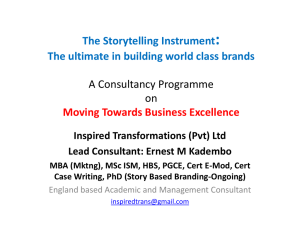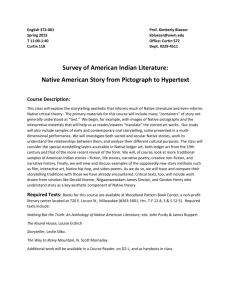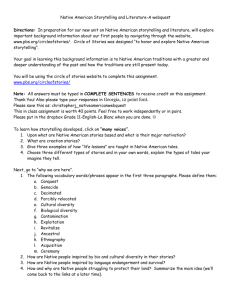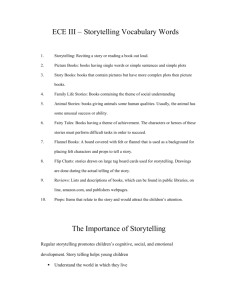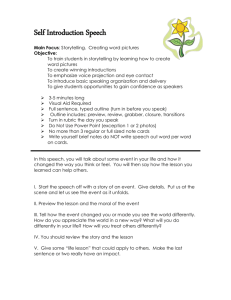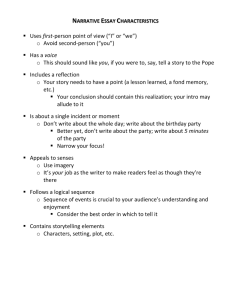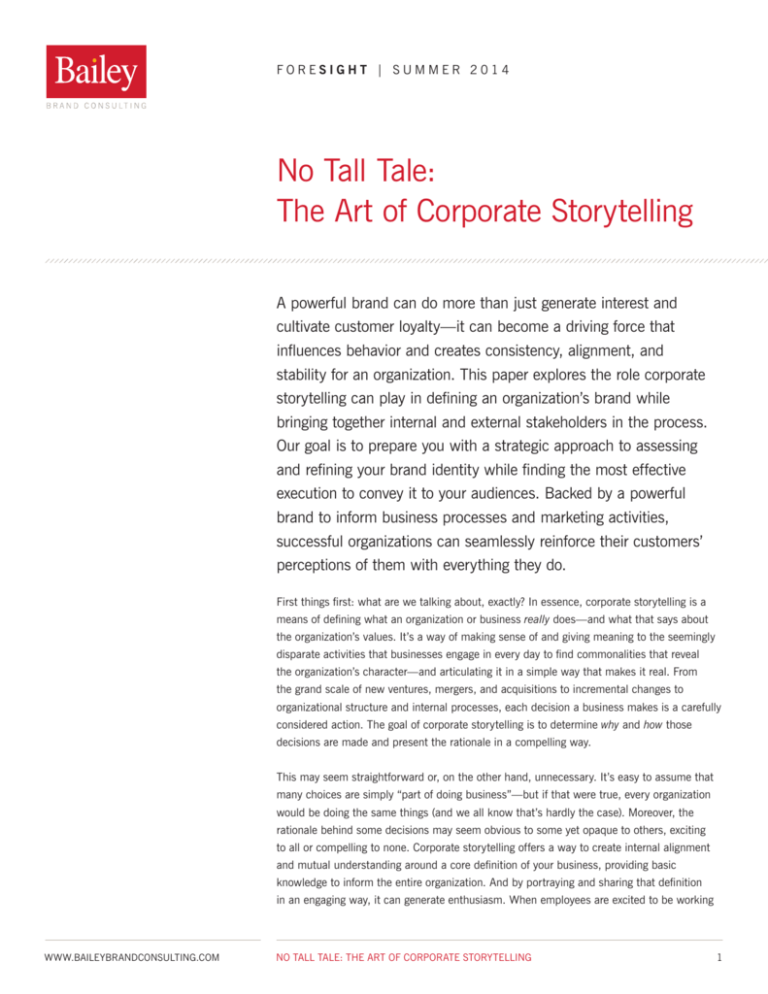
FORESIGHT | SUMMER 2014
No Tall Tale:
The Art of Corporate Storytelling
A powerful brand can do more than just generate interest and
cultivate customer loyalty—it can become a driving force that
influences behavior and creates consistency, alignment, and
stability for an organization. This paper explores the role corporate
storytelling can play in defining an organization’s brand while
bringing together internal and external stakeholders in the process.
Our goal is to prepare you with a strategic approach to assessing
and refining your brand identity while finding the most effective
execution to convey it to your audiences. Backed by a powerful
brand to inform business processes and marketing activities,
successful organizations can seamlessly reinforce their customers’
perceptions of them with everything they do.
First things first: what are we talking about, exactly? In essence, corporate storytelling is a
means of defining what an organization or business really does—and what that says about
the organization’s values. It’s a way of making sense of and giving meaning to the seemingly
disparate activities that businesses engage in every day to find commonalities that reveal
the organization’s character—and articulating it in a simple way that makes it real. From
the grand scale of new ventures, mergers, and acquisitions to incremental changes to
organizational structure and internal processes, each decision a business makes is a carefully
considered action. The goal of corporate storytelling is to determine why and how those
decisions are made and present the rationale in a compelling way.
This may seem straightforward or, on the other hand, unnecessary. It’s easy to assume that
many choices are simply “part of doing business”—but if that were true, every organization
would be doing the same things (and we all know that’s hardly the case). Moreover, the
rationale behind some decisions may seem obvious to some yet opaque to others, exciting
to all or compelling to none. Corporate storytelling offers a way to create internal alignment
and mutual understanding around a core definition of your business, providing basic
knowledge to inform the entire organization. And by portraying and sharing that definition
in an engaging way, it can generate enthusiasm. When employees are excited to be working
WWW.BAILEYBRANDCONSULTING.COM
NO TALL TALE: THE ART OF CORPORATE STORYTELLING
1
With a compelling
and aspirational
corporate narrative,
you can renew
enthusiasm while
giving employees a
reason to believe
in the work that
they—and the
organization—do.
for the organization and understand why their organization does what it does, they’re better
prepared to project that self-understanding externally. The result? A compelling brand story
that ensures a cohesive brand identity and is easily communicable—both internally and
externally. In fact, many leaders of some of the most influential companies credit their
success to the strength of their brand. With internal alignment and external consistency, the
message of your organization is more powerful. Thus equipped, your business activities can
bolster the strength of your brand to enhance your connections with your customers.
It would be natural for any organization to be a bit skeptical about the practicality of
storytelling. In fact, while the term may be a buzzword increasingly common within
marketers’ and content strategists’ vocabularies, the relevance to corporate branding may not
be obvious. This is a missed opportunity. Corporate storytelling can serve two distinct and
vital functions for an organization that should make it an important part of your brand-related
activities. It provides your workforce with “need-to-know” background, and it creates a
“reason to believe” that can inspire.
No matter the organization, its structure, its activities, or its industry, there’s always some
level of background that all employees need to know to not only fulfill their roles but to
integrate into the company as well. Familiarizing employees with the company’s history
and heritage is a great example of how to provide an introduction to the culture of the
organization—after all, culture is defined as a set of meanings and beliefs shared by a group.
Keeping employees aligned with a shared understanding of who they are, who the company
is, and how their role affects the organization does more than increase efficiencies, it creates
an emotional connection between employees and their work.
With a compelling and aspirational corporate narrative, you can renew enthusiasm while
giving employees a reason to believe in the work that they—and the organization—do. This
preempts the “what’s the point?” or “why am I doing this?” questions that can distract from
a business’s ultimate goals as well as helps give employees a broader vision that provides
context and insight into the significance of their individual roles. But to work, the narrative
must recognize the inherent challenges. Work isn’t easy—we all know that—so why cover it
up? As Robert McKee, renowned writer, director, and consultant, suggests, the best leaders
“appreciate that the people who work for them love the work and live for the small triumphs
that contribute to the final triumph”.1 Having a bold goal in sight is important, but to tell
a compelling corporate narrative, an organization must also “display the struggle between
expectation and reality in all its nastiness”.1
Told in an aspirational way, the corporate narrative can build passion and excitement among
employees—emotions that they’ll communicate externally. In McKee’s words, “if you look
your audience in the eye, lay out your really scary challenges, and say, ‘Well, we’ll be lucky
as hell if we get through this, but here’s what I think we should do,’ they will listen to you”.1
By openly and honestly telling the story of your organization’s challenges—past, present, and
future—and laying out the plan to overcome them and reach your goals, you create a tale
into which your employees can place themselves.
WWW.BAILEYBRANDCONSULTING.COM
NO TALL TALE: THE ART OF CORPORATE STORYTELLING
2
The goal of corporate
storytelling is really a
matter of creating a
culture—and culture
is a powerful tool for
creating sustainable
success.
This draws attention to an important characteristic of successful stories: making them
relatable. Being able to identify with a narrative and its characters allows audiences to
put themselves into the story, creating a connection and investment in the outcomes.
For a corporate narrative, this means making the struggle aspirational yet honest so that
stakeholders can relate to the challenge and want to be a part of facing it. When that
happens, they can clearly identify with their roles. And when all employees are aligned on
who they are, their external communications convey the same consistent message.
The more consistent a brand message is, the more powerful, engaging, and reliable it is
for its audience. So it should be no surprise that the same is true of a corporate narrative.
That’s because a well-defined and well-presented corporate narrative encompasses a brand’s
identity with effects both internal and external. The goal of corporate storytelling is really a
matter of creating a culture—and culture is a powerful tool for creating sustainable success.
Because as business activities cohere with the corporate narrative and brand message, that
narrative becomes a driver for a range of processes, practices, ventures, and more.
In each of its various
forms, storytelling
provides an important
tool for bringing
about change.
So, why do we do it? There is a range of possible outcomes to be gained through corporate
storytelling, and each desired result will influence the best approach to take. We’ve noted
that distilling the essence of an organization, its identity, and its mission can help explain it
and encourage internal alignment. The main point of that, though, is often to enable change.
It could be evolutionary (like launching a new product), revolutionary (like reorganizing a
production pipeline), or simply general change (like initiating a new campaign).
Let’s take an example. When Alan Mulally, outgoing CEO of Ford, first joined the company
back in September of 2006, the company struggled to unite a disparate portfolio of brands
and faced projected losses of $17 billion. To get the company back on track and develop a
strategy for continued future growth, Mulally returned to the roots of the organization, and he
and his team discovered a painted ad from 1925 in the company archives that would inspire
the story that could unite the company. The image depicts a family gazing into the distance
at an industrializing America with the headline, “Opening the Highways to All Mankind.” As
Mulally describes in a 2013 interview with Fast Company, “There was the vision of Ford...
and that could be the vision of Ford going forward, where everybody would understand
what Ford stood for, and everybody could align themselves and their work to create an
exciting, viable, profitable, growing company.”2 The company vision as conveyed in that
historical ad became the story that would influence the company’s current decisions and
drive Ford’s culture going forward.
In each of its various forms, storytelling provides an important tool for bringing about change.
It can help articulate the value proposition of a new venture, which provides an easier case
for change internally and simplifies your external communications. Or, storytelling can help
breathe new life into an organization, building excitement and stimulating internal support for
an organization’s activities.
WWW.BAILEYBRANDCONSULTING.COM
NO TALL TALE: THE ART OF CORPORATE STORYTELLING
3
The timeline approach to
storytelling is incredibly
useful for creating
a definition of an
organization’s identity.
Think about it. In the Ford example, employees needed a reason to get on board with
Mulally’s ambition or change would not have been achievable. But because his efforts fit
with—and were inspired by—the company narrative with which they’re all familiar, it’s easier
for employees to identify with the principles behind the decision and they’re more likely to
support it. Effecting change becomes a lot easier.
Telling a great story takes more than a cast of compelling characters and an engaging plot.
When it comes to telling the story of an organization, there are two main questions to ask,
one self-reflective, the other tactical.
The timeline approach to storytelling is incredibly useful for creating a definition of
an organization’s identity. It requires taking a look back at the past and analyzing an
organization’s behavior, essentially asking, how did we get to where we are today and what
does that say about us? It’s a matter of taking an honest look at the organization, recognizing
both its successes and failures, challenges and opportunities, strengths and shortcomings.
Anniversaries are the classic time to do a retrospective assessment, yet many brands miss
the opportunity to really derive value from a look back. But with a strong self-definition, you
can then ask the more important question: what does this past suggest about how we should
act in the future?
With the story defined, the next challenge is to execute and find the best way to tell it, share
it, and build some buzz about it. The greatest story in the world only has as much impact as
the number of people it reaches and influences. There are, of course, a number of possible
executions available, and the right one depends on the nature of the story you need to tell
and the audience you’re trying to reach. A video may be fit for a presentation to customers, but
a simpler graphic may be better for a shareholder meeting. In addition to the different audiences,
both of these example scenarios also has a very different goal with very different needs.
CHIPOTLE CAMPAIGN IMPRESSIONS 3
Chipotle received over 126 million
impressions in response to their
“The Scarecrow” campaign
Over 11.6 million views on YouTube
Chipotle’s The Scarecrow campaign is an excellent example of engaging storytelling
coordinated to explain—and capitalize on—a business decision. The campaign, launched in
late 2013 through social media channels, centers around an ambitious video depicting the
tale of a Scarecrow who eschews the dystopian industrial food production plant he works at
to begin growing wholesome, unadulterated food on his own farm. It’s a touching animated
tale complete with haunting soundtrack, and it’s a way for Chipotle to start a conversation
Over 12,000 Facebook posts
Over 31,000 Tweets (from more than
26,000 unique users)
about food ethics that isn’t overt marketing per se but nonetheless draws attention to their
commitment to ethically-raised livestock and family farms. Through a simple story, Chipotle
connected with its core Millennial audience with staggeringly positive results and over 126
million impressions.3
Aligning a story’s execution to its audience is important for communicating effectively,
but, equally important, it creates consistency for your brand. Just as traditional marketing
activities should cohere to your core brand principles, so too should storytelling complement
and reinforce your corporate identity to build a brand that your customers can trust. An
easily communicable, engaging corporate story can give external audiences a foundational
WWW.BAILEYBRANDCONSULTING.COM
NO TALL TALE: THE ART OF CORPORATE STORYTELLING
4
understanding of your business in much the same way it works for internal audiences. This
gives your audience a way to make sense of your activities while ensuring that everything you
do reinforces that core essence. And when business behaviors reinforce the message of your
brand, your audience (i.e. customers) can respond to your actions and message better. That
means that your audience has a clearer understanding of who you are, what you stand for,
and why you act the way you do, allowing you to create stronger connections with them and
have an ongoing influence over their perceptions of your brand.
If you are interested in learning more about how to use corporate
storytelling in your organization, please visit us at:
www.baileybrandconsulting.com
About This Paper
We believe collaboration is the key to achieving successful results—and we put this into
practice with both our clients and our internal teams on a regular basis. The paper you just
read reflects that philosophy; it was a team effort, created from the observations and
combined thinking of both our Client and Creative Services teams.
About the Author
As founder and CEO of our firm, Chris Bailey is responsible for overall management and
direction, including shaping and implementing our vision and mission.
Chris Bailey
About Bailey Brand Consulting
Bailey Brand Consulting has been building effective brand strategies for clients across the
country and around the world since 1985. The firm is guided by two core principles: that
creating an emotional connection with consumers builds brand loyalty and that close
collaboration with clients is key to producing those enduring bonds. Now one of the largest
branding and creative firms in metro Philadelphia, Bailey is also a founding member of Global
Design Source, a network of international experts in branding, print, digital, and product design.
Selected Sources:
1. McKee, Robert and Bronwyn Fryer. “Storytelling That Moves People.” Harvard Business Review.
2. Gray, Tyler. “How a Painting from 1925 Inspired Ford’s Customer-Focused Future.” Fast Company. June 2013.
3. Weiss, Michael. “This Chipotle Ad is Not an Ad.” Chief Content Officer. April 2014.
©2014 Bailey Brand Consulting. All rights reserved.
WWW.BAILEYBRANDCONSULTING.COM
NO TALL TALE: THE ART OF CORPORATE STORYTELLING
5


